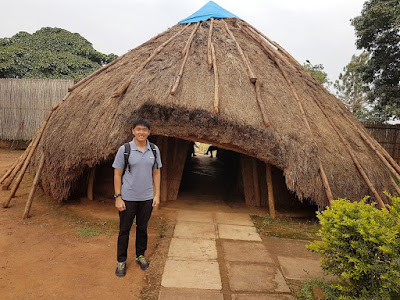Kyoto, Japan
Known as Kyoto's most famous geisha (lit. arts person) district, Gion holds a profound historical legacy tracing back to the Sengoku period that spanned from the 15th to the 16th century. The district originated as one designed to cater to the visitors to Yasaka Shrine, a focal point of the Shinto faith in the region.
---
JPN: Gion District @ Kyoto Prefecture <YOU ARE HERE!>
Stepping out of Gion-Shijo station, my family and I found ourselves wandering through rows of charming shops as we made our way to Yasaka Shrine.
 |
| Minami-za is the primary kabuki, a classical form of Japanese performance, theatre in Kyoto. |
 |
| Pringles with a distinctive taste of takoyaki (Japanese octopus balls) can only be found in the Kansai region. |
Is anyone here a fan of Miffy?

 |
| Sometimes I can't bear indulging in cute-looking buns. |
Along the way, we dropped by a small shrine.
Once called Gion Shrine dedicated to Susanoo, the Shinto god associated with the sea and storms, Yasaka Shrine was constructed in 656.
You may be interested in checking out some food vendors as you step into the grounds of the shrine through the front entrance.
I was at Gion, joining the crowd on their way to the shrine to usher in the new year of 2013. Despite my usual inclination to avoid large gatherings, I just had to partake in the new year celebration the local way at least once in my life. What struck me was the police addressing the crowd in keigo (Japanese honorific language), adding a touch of formality to the spirited atmosphere.
 |
Gion Matsuri stands as the most famous festival of the shrine, and arguably the entire country, held annually in July.
|
 |
| That's a dance stage adorned with lanterns, each bearing the name of a local business in appreciation for donation. |
Sometime after leaving the shrine, we were lucky enough to spot a geisha in the afternoon. Do refrain from taking photos of them without permission to respect their privacy.
 |
| Some of the wooden merchant homes from the yesteryear have been repurposed into restaurants and teahouses. |
 |
| Japanese crane symbolises peace, longevity and luck. |
Look at the pristine clarity of the river water!
Pontocho is one of Kyoto's most atmospheric dining streets. The narrow alley is quiet during the day as many establishments are open only from 5.00pm onwards, but transforms into a magical corridor as dusk falls.
 |
| I was so enticed by the aroma of the grilled skewers wafting through the air. |
 |
| Pontocho is a portmanteau of the Portuguese word ponte (lit. bridge) and the Japanese word cho (lit. street). |
Though I didn't have lunch there, I recall visiting,
Kichi Kichi, which has gained widespread fame through a viral video showcasing its chef's extraordinary skill in dishing out ridiculously fluffy upside-down omelette rice. I also visited
Izumoya and
Mimasuya previously.
Before bidding farewell to the enchanting locale, we had a leisurely stroll along Kamogawa (lit. Duck River).
Having visited Gion three times, I continue to find myself drawn to its charm, discovering new facets of the district with each visit.











































Comments
Post a Comment